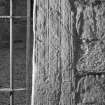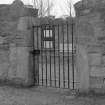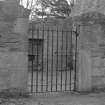Following the launch of trove.scot in February 2025 we are now planning the retiral of some of our webservices. Canmore will be switched off on 24th June 2025. Information about the closure can be found on the HES website: Retiral of HES web services | Historic Environment Scotland
Abercrombie Church And Churchyard
Burial Ground (Medieval), Carved Stone(S) (Medieval), Chapel (Medieval), Church (Medieval)
Site Name Abercrombie Church And Churchyard
Classification Burial Ground (Medieval), Carved Stone(S) (Medieval), Chapel (Medieval), Church (Medieval)
Alternative Name(s) Chapel
Canmore ID 34195
Site Number NO50SW 1
NGR NO 52189 03433
Datum OSGB36 - NGR
Permalink http://canmore.org.uk/site/34195
- Council Fife
- Parish St Monance
- Former Region Fife
- Former District North East Fife
- Former County Fife
NO50SW 1 52189 03433
(NO 5218 0343) Abercrombie Church (NR) (In Ruins)
OS 6" map (1938)
There are five sculptured stones, showing Celtic ornament, in the walls of Abercrombie Church.
J Stuart 1856; J R Allen and J Anderson 1903.
The chapel of Abercrombie was granted to Dunfermline Abbey by William the Lion in 1165. It was dedicated in 1247.
D H Fleming 1886
The roofless ruin of Abercrombie Church measures 46 1/2' x 23' externally. The gables are crow-stepped and the S gable is recessed from the wall head. The present entrance is in the N wall; fragments of early tombstones are built into its jambs.
There are also several late medieval stones outside the church.
RCAHMS 1933.
Field Visit (21 July 1927)
Abercrombie Church.
The ruin of this church stands on the Balcaskie estate; rather more than 300 yards south-west of the mansion. It is a roofless shell without features of special interest. On plan it is oblong, measuring 46 ½ feet by 23 feet externally. The masonry is rubble, the gables are crow-stepped, and the southern gable is recessed from the wall-head. The present entrance is in the north wall, and into its jambs are built fragments of early tombstones, which are noted in their order thus:
(1) A fragment in the upper part of the eastern jamb measures 1 foot 7 inches in height by 1 foot 3 inches in breadth and bears a Latin cross, hollowed at the junction of the arms with the shaft and enriched with a key pattern.
(2) Below it is a fragment of a cross-shaft, 7 inches thick and with a present height of 1 foot 3 inches and a breadth of 1 foot 3 ½ inches; the edge has been defined by a bead. The face bears traces of a key pattern, while the side appears to have been later cleaned off and stugged.
(3) A stone below (2) measures 1 foot 2 inches in breadth by 6 ¼ inches in height and bears a small knotwork panel.
(4) At the level of (3) is the upper part of a cross-slab. It measures 1 foot 7 inches in height, is 1 foot 4 inches broad and 7 ½ inches thick. On the face is the upper part of a Latin cross, the arms and shaft being defined by knotwork panels; the side bears a spiral scroll.
(5) Lower down is a stone 3 feet 1 ½ inches in height, 1 foot 5 inches broad, and 4 ½ inches thick. It is built in upside down. The face only is sculptured and bears a disc-headed cross, hollowed at the junctions of the arms with the shaft. On either side of the upper arm is a panel bearing what appears to be a fret pattern, and there is a fret pattern on either side of the shaft towards the base.
(6) The uppermost of the three fragments in the west jamb measures 1 foot in length, 9 inches in height, and 3 ¾ inches in thickness. The face bears a double spiral and a fret pattern wrought by a series of punching blows and obviously never finished.
(7) A fragment below (6) measures 1 foot 7 inches in height, 1 foot 4 inches broad, and 6 inches in thickness and has evidently belonged to the same tombstone as (4); on the side is a scroll work, while the face bears an incised shaft.
(8) At the lower part of the jamb is a stone inserted upside down. It measures 3 feet 10 ½ inches in height, 1 foot 1 ¾ inches in breadth: and 5 ½ inches in. thickness. It bears a shaft with hollowed angles terminating in a mount. The cross is defined by plain panels.
In addition to these early fragments there are several late mediaeval stones outside the church.
(1) Against the west gable is the tombstone of Thomas Abercrombie on which is a shield flanked by the initials T.A., and bearing: A chevron between three boars' heads erased, for Abercrombie.
(2) Lying south of the church is the table stone of "Alexander Irland 1639" on which is a shield flanked by the initials A.I., and bearing: On a fess between three mullets a boar's head.. A second shield, flanked by the initials M.W., bears: An oak-tree eradicated, surmounted by a fess charged with a crescent between two mullets, for Watson.
HISTORICAL NOTE. - Until 1646, the parish was known as Abercrombie. In that year Sir James Sandilands of Newark (cf. NO50SW 17) acquired the estate of Abercrombie, while Newark was in the neighbouring parish of Kilconquhar. He secured the annexation of Newark to the parish of Abercrombie, and this had the effect of bringing the church of St. Monans into the latter parish. The Act of Parliament effecting the disjunction is of 1649 (cf. further NO50SW 18). The parish was then styled "Abercrombie with St. Monance," but in course of time the name was reduced to its present form, while the church of Abercrombie was abandoned and allowed "to go into ruin" (1).
RCAHMS 1933, visited 21 July 1927.
(1) Stat. Acct., ix, pp. 334-5. Wood's East Neuk of Fife, p. 254.
Field Visit (29 May 1974)
The church, as described, lies in the disused burial ground. The sculptured stones, although weathered, are as llustrated.
Visited by OS (DWR), 29 May 1974
Photographic Survey (March 1993)
Photographs of the carved stones in Abercrombie churchyard, Fife by Tom E Gray in 1993.
External Reference
NO50SW 1 52189 03433
REFERENCE:
SCOTTISH RECORD OFFICE:
Repair of the old chapel.
Mr Foggo, the minister, writes to Sir Robert Abercromby concerning the condition of the Abercrombie tomb in the churchyard. He mentions that the old chapel has been repaired recently by Sir Ralph Anstruther.
1848 GD 185/1/bundle 27




















































































































